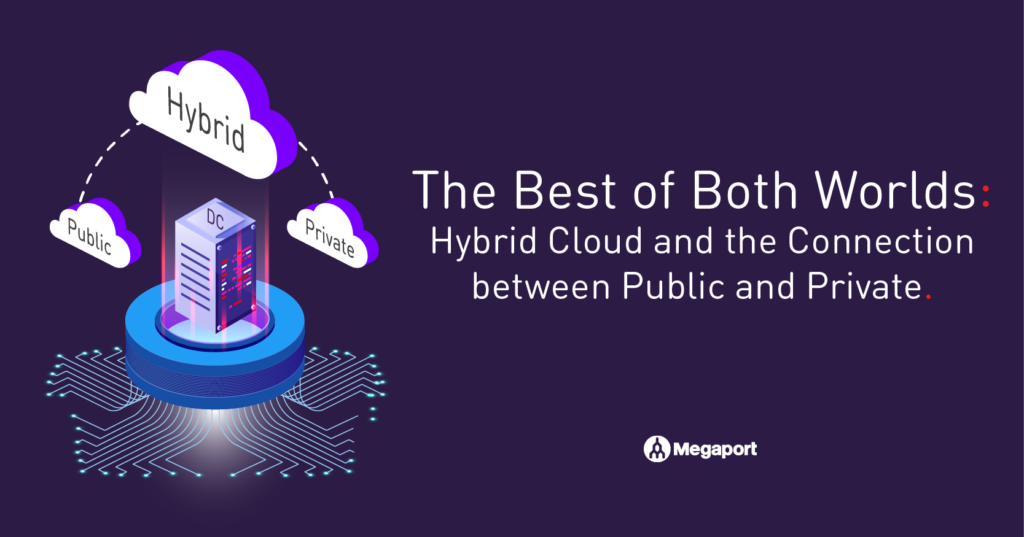
The Best of Both Worlds: Hybrid Cloud and the Connection Between Public and Private
- March 6, 2019
- RSS Feed
Connecting to on-premises and public cloud resources doesn’t have to mean sacrificing the benefits of either environment.
When cloud technology first burst onto the enterprise market, IT leaders and networking teams were faced with a very difficult choice. Should they embrace public cloud solutions and gain unparalleled flexibility at the cost of control, or opt for private cloud offerings, enabling them to retain total control over their data and security, at the cost of manageability and agility?
Over time, many have come to realise that, ultimately, the choice between public or private cloud solutions depends greatly on the type of workload you’re migrating or creating. For some applications and services where total control over data isn’t necessary, public is a great fit. Whereas for others where data sovereignty and security are paramount, private is the natural choice.
So, in the quest to build the perfect cloud environment, the vast majority of businesses today have come to accept that a hybrid cloud – incorporating both public and private cloud services – is the ideal way forwards.
By integrating public and private cloud solutions and running them alongside one another in a single environment, businesses really can get the best of both worlds. However, engineering a perfectly integrated hybrid cloud environment creates new connectivity challenges for the networking team – challenges that demand creative and occasionally complex solutions.
Building the perfect connection between public and private clouds
While public and private cloud will both make sense as deployment options for different applications and services, there’s also a bigger cloud picture for the network team to look at. Ultimately, no matter where or how you deploy your services, you need them to be able to integrate, and function alongside one another in a consistent and connected IT environment.
With some resources deployed on-premises, and others deployed across private clouds, the only way to ensure this enterprise-wide integration and interoperability is with a consistent connectivity layer that brings everything together.
The good news is that, today, the technology required to establish that connectivity layer is also available in the cloud. Tools such as Virtual Cross Connects (VXCs) and Virtual Routers (VRs) for managing Border Gateway Protocols can streamline the interconnection of cloud and on-premises systems, and help you design and orchestrate the perfect hybrid cloud environment.
With this layer in place, services can easily share data and communicate with one another, giving you all of the advantages of an environment that’s deployed in one place, blended with the freedom to gain everything the cloud and on-premises IT have to offer.
When hybrid meets multicloud
Hybrid cloud has become an incredibly popular approach to enterprise IT because of the freedom and choice it gives businesses in which tools they can utilise, and how they can utilise them. But true cloud freedom usually means accessing services from multiple different partners or vendors.
These multicloud environments, where a wide range of services are deployed, have created further challenges for those adopting the hybrid cloud model. In addition to having to maintain a consistent connectivity layer that integrates cloud and on-premises services together, they also need a dedicated way to connect to multiple cloud vendors.
For those that need to access multiple services from diverse cloud partners in a simple and consolidated way, direct CSP connectivity isn’t an option – but because of their enterprise security and performance demands, public internet connectivity doesn’t stack up either.
Many of the companies in this position have now begun looking to dedicated connectivity partners like Megaport to help them securely and reliably connect to diverse cloud services, and seamlessly weave multicloud application and service portfolios into their hybrid cloud strategies.
Bringing everything together with the help of a dedicated connectivity partner
Managing hybrid cloud connectivity and getting the best of both worlds is all about how effectively you can bring everything together. Once you’ve chosen your ideal cloud and on-premises resources, what you can get from them will depend on the connectivity layer you create to help them interact with one another and speak a common networking language.
If you’re using services from multiple cloud vendors, your connectivity layer will also need to take that into account – providing you with a way of reliably connecting to diverse vendors at the same time, without impacting service integration or interoperability.
It’s a tall order for any networking team, but with the help of the right partner, it’s very achievable. Once you’ve worked to establish exactly what your business needs to get from hybrid cloud, speak to us and we’ll help you understand exactly how the right networking and connectivity solutions can help you deliver the best of both worlds for everyone.


